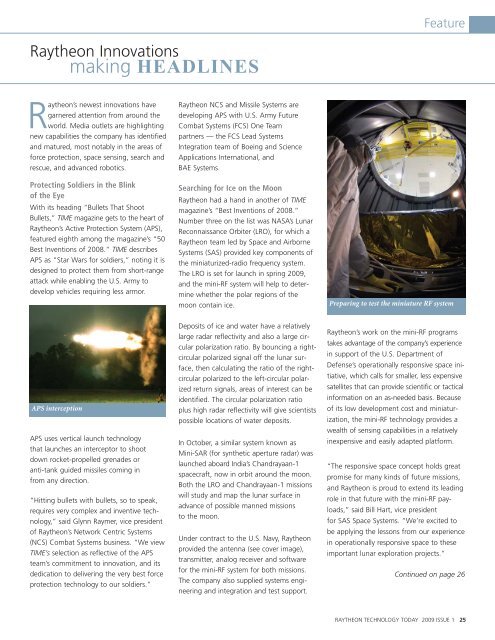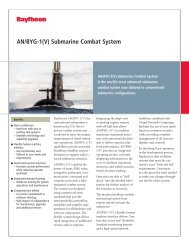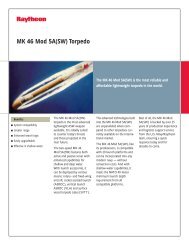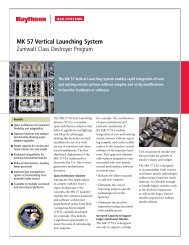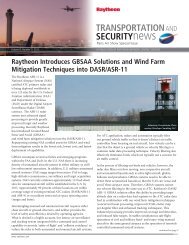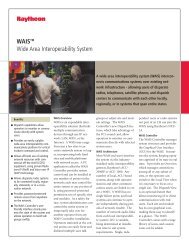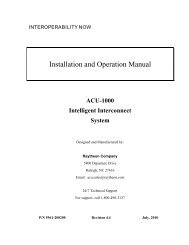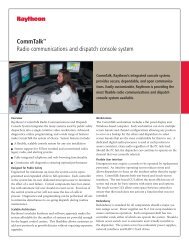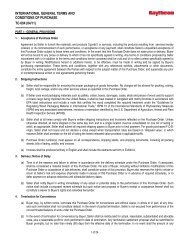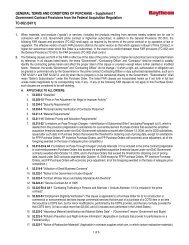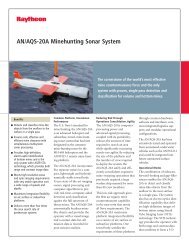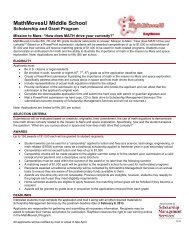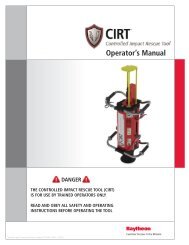Tech_Issue 1 2009_0127_Final:TechToday_012709 ... - Raytheon
Tech_Issue 1 2009_0127_Final:TechToday_012709 ... - Raytheon
Tech_Issue 1 2009_0127_Final:TechToday_012709 ... - Raytheon
Create successful ePaper yourself
Turn your PDF publications into a flip-book with our unique Google optimized e-Paper software.
<strong>Raytheon</strong> Innovations<br />
making HEADLINES<br />
<strong>Raytheon</strong>’s newest innovations have<br />
garnered attention from around the<br />
world. Media outlets are highlighting<br />
new capabilities the company has identified<br />
and matured, most notably in the areas of<br />
force protection, space sensing, search and<br />
rescue, and advanced robotics.<br />
Protecting Soldiers in the Blink<br />
of the Eye<br />
With its heading “Bullets That Shoot<br />
Bullets,” TIME magazine gets to the heart of<br />
<strong>Raytheon</strong>’s Active Protection System (APS),<br />
featured eighth among the magazine’s “50<br />
Best Inventions of 2008.” TIME describes<br />
APS as “Star Wars for soldiers,” noting it is<br />
designed to protect them from short-range<br />
attack while enabling the U.S. Army to<br />
develop vehicles requiring less armor.<br />
APS interception<br />
APS uses vertical launch technology<br />
that launches an interceptor to shoot<br />
down rocket-propelled grenades or<br />
anti-tank guided missiles coming in<br />
from any direction.<br />
“Hitting bullets with bullets, so to speak,<br />
requires very complex and inventive technology,”<br />
said Glynn Raymer, vice president<br />
of <strong>Raytheon</strong>’s Network Centric Systems<br />
(NCS) Combat Systems business. “We view<br />
TIME’s selection as reflective of the APS<br />
team’s commitment to innovation, and its<br />
dedication to delivering the very best force<br />
protection technology to our soldiers.”<br />
<strong>Raytheon</strong> NCS and Missile Systems are<br />
developing APS with U.S. Army Future<br />
Combat Systems (FCS) One Team<br />
partners — the FCS Lead Systems<br />
Integration team of Boeing and Science<br />
Applications International, and<br />
BAE Systems.<br />
Searching for Ice on the Moon<br />
<strong>Raytheon</strong> had a hand in another of TIME<br />
magazine’s “Best Inventions of 2008.”<br />
Number three on the list was NASA’s Lunar<br />
Reconnaissance Orbiter (LRO), for which a<br />
<strong>Raytheon</strong> team led by Space and Airborne<br />
Systems (SAS) provided key components of<br />
the miniaturized-radio frequency system.<br />
The LRO is set for launch in spring <strong>2009</strong>,<br />
and the mini-RF system will help to determine<br />
whether the polar regions of the<br />
moon contain ice.<br />
Deposits of ice and water have a relatively<br />
large radar reflectivity and also a large circular<br />
polarization ratio. By bouncing a rightcircular<br />
polarized signal off the lunar surface,<br />
then calculating the ratio of the rightcircular<br />
polarized to the left-circular polarized<br />
return signals, areas of interest can be<br />
identified. The circular polarization ratio<br />
plus high radar reflectivity will give scientists<br />
possible locations of water deposits.<br />
In October, a similar system known as<br />
Mini-SAR (for synthetic aperture radar) was<br />
launched aboard India’s Chandrayaan-1<br />
spacecraft, now in orbit around the moon.<br />
Both the LRO and Chandrayaan-1 missions<br />
will study and map the lunar surface in<br />
advance of possible manned missions<br />
to the moon.<br />
Under contract to the U.S. Navy, <strong>Raytheon</strong><br />
provided the antenna (see cover image),<br />
transmitter, analog receiver and software<br />
for the mini-RF system for both missions.<br />
The company also supplied systems engineering<br />
and integration and test support.<br />
Feature<br />
Preparing to test the miniature RF system<br />
<strong>Raytheon</strong>’s work on the mini-RF programs<br />
takes advantage of the company’s experience<br />
in support of the U.S. Department of<br />
Defense’s operationally responsive space initiative,<br />
which calls for smaller, less expensive<br />
satellites that can provide scientific or tactical<br />
information on an as-needed basis. Because<br />
of its low development cost and miniaturization,<br />
the mini-RF technology provides a<br />
wealth of sensing capabilities in a relatively<br />
inexpensive and easily adapted platform.<br />
“The responsive space concept holds great<br />
promise for many kinds of future missions,<br />
and <strong>Raytheon</strong> is proud to extend its leading<br />
role in that future with the mini-RF payloads,”<br />
said Bill Hart, vice president<br />
for SAS Space Systems. “We’re excited to<br />
be applying the lessons from our experience<br />
in operationally responsive space to these<br />
important lunar exploration projects.”<br />
Continued on page 26<br />
RAYTHEON TECHNOLOGY TODAY <strong>2009</strong> ISSUE 1 25


